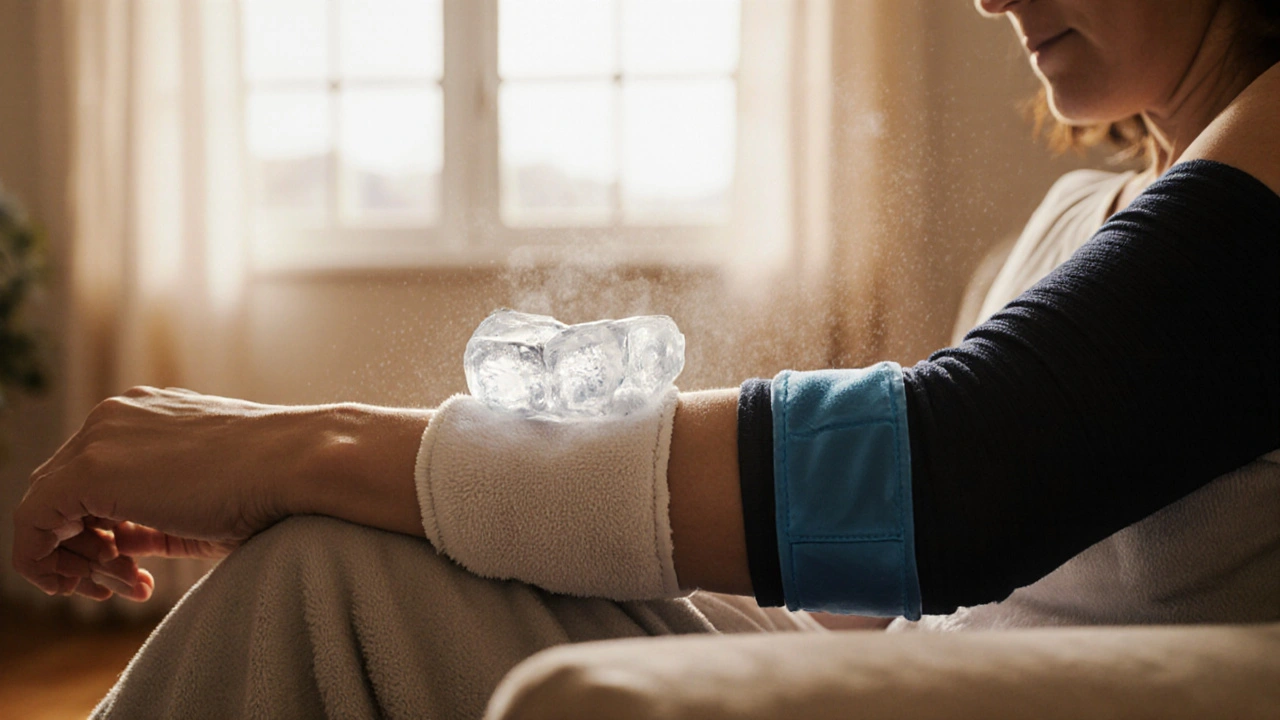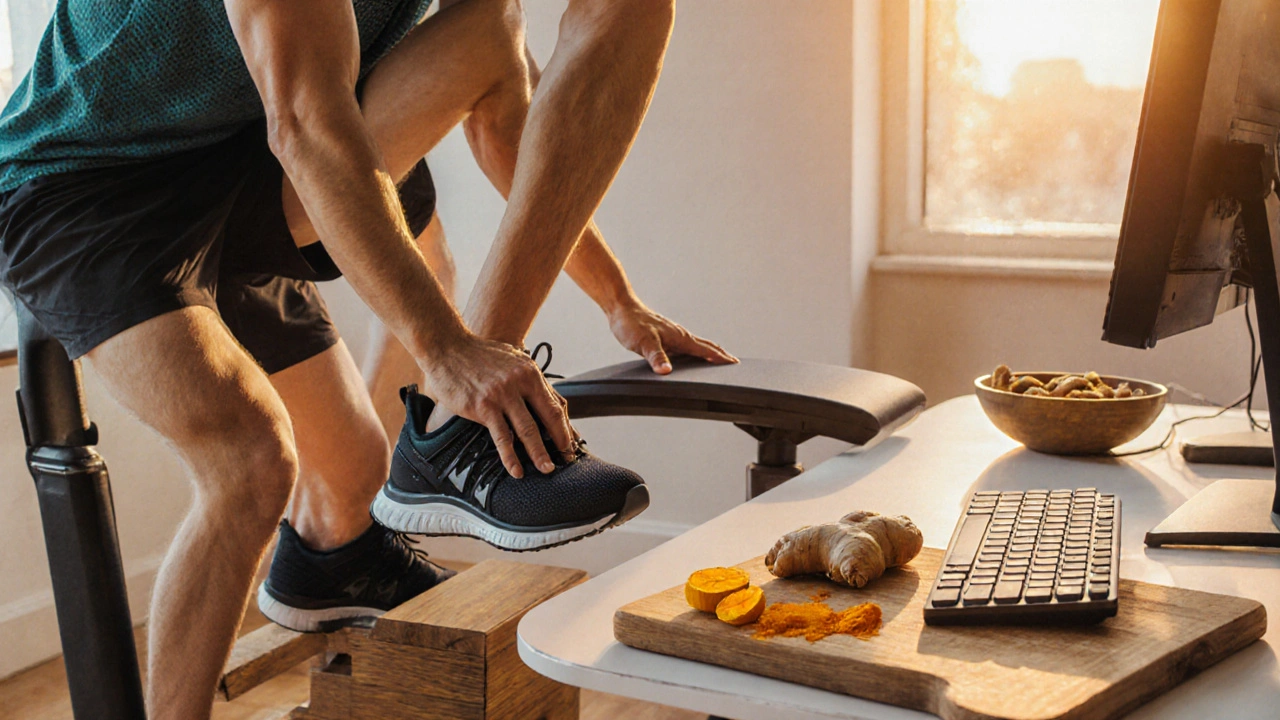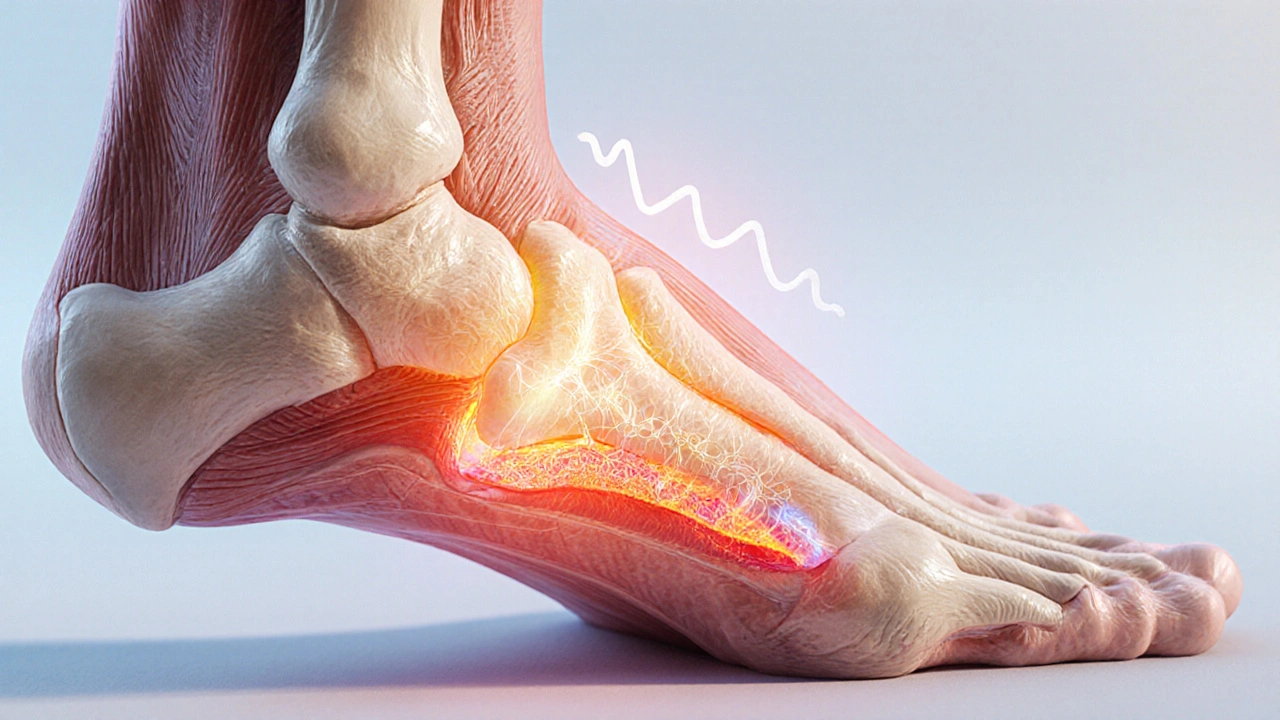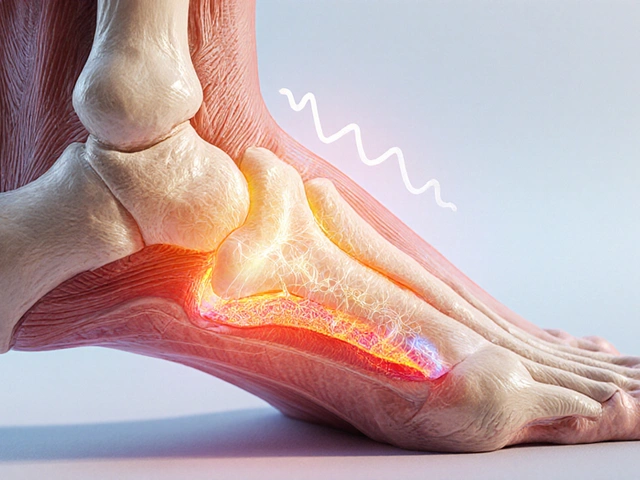Tendonitis Pain Tracker
Daily Pain Log
Recovery Progress
Track your healing journey with daily entries. Aim for consistent improvement over time.
Key Takeaways
- Rest, ice, and gentle movement are the cornerstones of immediate relief.
- Targeted stretching and eccentric strengthening reduce recurrence.
- Anti‑inflammatory herbs such as turmeric and ginger can complement physical methods.
- Ergonomic tweaks at work or sport help keep the tendon from re‑overloading.
- Combine strategies into a personal plan and track progress daily.
What Is Tendonitis?
When you hear the term Tendonitis is an inflammation of a tendon caused by overuse, sudden strain, or age‑related wear, the picture becomes clearer. A tendon is the fibrous cord that links muscle to bone, and Inflammation is the body’s natural response to irritation, bringing fluid, heat, and immune cells to the site. The result is pain, stiffness, and sometimes swelling, especially during movement. Common hotspots include the Achilles, rotator cuff, wrist extensors, and elbow’s tennis‑in‑law. Risk factors range from repetitive typing to high‑intensity running, making it a frequent complaint for office workers, athletes, and DIY hobbyists alike.
Immediate Relief: Rest, Ice, and Compression
If you’re battling tendonitis pain, the first 48‑hour window is crucial. The goal is to blunt the inflammatory surge without letting the tendon stiffen permanently.
Ice Therapy
Apply a cold pack for 15‑20 minutes every 2‑3 hours. The cold causes blood vessels to constrict, limiting swelling and numbing nerve endings.
Ice pack is a reusable gel or frozen‑vegetable bundle that can be wrapped in a thin towel before placement on the skin. Avoid direct contact to prevent frostbite.
Compression
Elastic wraps or compression sleeves add gentle pressure, encouraging fluid return to the circulatory system. Choose a snug but not tight fit, and remove the bandage before sleeping.
Rest and Elevation
Set the affected limb above heart level when possible. This reduces hydrostatic pressure, aiding the drainage of inflammatory fluid.

Heat and Controlled Motion: When to Switch
After the initial swelling subsides (usually 48‑72hours), heat can restore flexibility. Warmth dilates blood vessels, delivering oxygen‑rich blood that fuels tissue repair.
Heat Therapy
Use a warm towel, heating pad, or warm‑water soak for 10‑15 minutes before stretching. Aim for a temperature that feels comfortably hot, not burning.
Gentle Stretching
Stretching should be pain‑free and held for 20‑30 seconds. Focus on the muscle that feeds the irritated tendon. For Achilles tendonitis, a calf stretch against a wall works well; for forearm tendonitis, gently extend the wrist and fingers.
Stretching is a controlled lengthening of muscle fibers that improves range of motion and reduces tension on the tendon. Consistency beats intensity-perform stretches 2‑3 times daily.
Exercise Therapy: Strengthening the Weak Links
Once pain eases, rebuilding tendon resilience is essential. Eccentric (lengthening) exercises have the strongest evidence for preventing re‑injury.
Eccentric Calf Raises (Achilles)
- Stand on a step with heels hanging off.
- Rise onto both forefeet, then lift the uninjured leg.
- Slowly lower the injured heel below the step level (3‑5 seconds).
- Perform 3 sets of 15 reps, twice daily.
Wrist Extensor Eccentrics (Forearm)
- Hold a light dumbbell (1-2kg) with palm facing down.
- Lift the wrist upward (concentric), then slowly lower it past neutral.
- Complete 3 sets of 12 reps, once per day.
Strength training involves progressive overload of muscle‑tendon units, encouraging collagen synthesis and alignment. Start light, increase weight by no more than 10% each week, and always end with a brief stretch.
Herbal and Nutritional Allies
Dietary anti‑inflammatories can tip the internal balance toward healing. They work alongside physical methods, not as a replacement.
Turmeric (Curcumin)
Curcumin, the active compound in turmeric, inhibits NF‑κB, a key driver of inflammatory cytokines. A daily dose of 500mg of standardized extract (with black‑pepper piperine for absorption) can reduce soreness within a week.
Turmeric is a bright yellow spice whose curcumin content offers measurable anti‑inflammatory effects. Add it to smoothies, soups, or take it in capsule form.
Ginger
Similar to turmeric, ginger contains gingerols that blunt prostaglandin synthesis. Drinking 1‑2 cups of fresh ginger tea daily can complement other measures.
Omega‑3 Fatty Acids
Found in fatty fish, chia seeds, and walnuts, omega‑3s lower systemic inflammation. Aim for 1g EPA/DHA combined each day, either via diet or high‑quality fish oil.
Bromelain
Derived from pineapple, bromelain is a proteolytic enzyme that reduces swelling. A typical dose is 500mg taken with meals, but watch for mild digestive upset.

Lifestyle Tweaks to Prevent Relapse
Even the best rehab plan can be undone by poor habits. Small ergonomic changes often make the biggest difference.
- Workstation setup: Keep keyboard and mouse at elbow height, use a wrist‑rest, and take a 5‑minute break every hour to move.
- Footwear: Choose shoes with adequate arch support and cushioning, especially for runners.
- Training volume: Increase mileage or load by no more than 10% per week; incorporate rest days.
- Warm‑up routine: 10 minutes of dynamic movement (leg swings, arm circles) prepares the tendon for stress.
Putting It All Together: Your Personal Tendonitis Management Plan
Every tendon responds differently, so tailor the steps to your schedule and symptom level.
- Day1‑2: Rest, elevate, compress, and apply ice for 15minutes every 2hours.
- Day3‑5: Begin gentle heat before a short stretch routine (2-3minutes of warm towel, then 20‑second stretches).
- Day6‑10: Add eccentric strengthening (once daily) while maintaining ice after workouts if soreness returns.
- Ongoing: Incorporate anti‑inflammatory herbs (turmeric, ginger) and omega‑3s in meals. Review ergonomics and adjust as needed.
- Weekly check‑in: Log pain level (0‑10 scale), activity performed, and any flare‑ups. Adjust volume or add an extra rest day if the score rises above 4.
Consistency is the magic word. Most people report a noticeable drop in pain within 2‑3 weeks when they stick to the plan.
Quick Comparison of Natural Remedies
| Remedy | Mechanism | Best For | Pros | Cons |
|---|---|---|---|---|
| Ice pack | Vasoconstriction reduces swelling | Acute flare‑ups | Fast, inexpensive | Only short‑term relief |
| Heat therapy | Vasodilation improves blood flow | Stiffness after swelling subsides | Promotes flexibility | Can worsen fresh inflammation |
| Stretching | Lengthens muscle, reduces tendon load | Chronic tightness | Can be done anywhere | Requires consistency |
| Eccentric strengthening | Stimulates collagen remodeling | Preventing recurrence | Long‑term tendon health | Initial soreness possible |
| Turmeric (curcumin) | Inhibits inflammatory pathways | Systemic inflammation | Easy to add to diet | Absorption needs piperine |
Frequently Asked Questions
How long should I ice a tendonitis flare‑up?
Apply a cold pack for 15‑20 minutes, then remove it for at least 40 minutes. Repeat every 2‑3 hours during the first 48hours. Avoid keeping ice on for longer than 20 minutes to prevent skin damage.
Can I use heat right after icing?
Wait until swelling eases (usually 48‑72hours) before introducing heat. Switching too early can prolong inflammation.
What dosage of turmeric is effective for tendonitis?
Clinical studies use 500mg of standardized curcumin extract taken twice daily, paired with a pinch of black pepper to boost absorption.
Should I completely stop exercising during recovery?
Total rest isn’t necessary. Gentle, non‑painful movement and the specific eccentric program outlined above keep the tendon healthy while allowing healing.
Is compression always beneficial?
Compression helps in the acute phase to control swelling, but it should be removed before sleep and not be so tight that it cuts off circulation.



Lawrence Bergfeld
October 12, 2025 AT 13:28Ice early, compress lightly, elevate above heart level; repeat every 2‑3 hours, and you’ll curb swelling fast.
Chelsea Kerr
October 12, 2025 AT 14:51Great rundown on tendonitis management! I love how you blend ice, heat, and eccentric exercises in a clear timeline. The herbal tips like turmeric and ginger add a nice holistic touch 😊. Remember to pair the supplements with a balanced diet for optimal absorption. Consistency is key, so logging daily progress really helps you stay on track 📊.
Tom Becker
October 12, 2025 AT 16:15Yo, they don’t tell you in the mainstream that the “natural remedies” are just a cover‑up, right? The pharma industry is keepin’ us in the dark, pushin’ pills while they sell the “herbs” as a side hustle. Definatly don’t trust the so‑called “experts”, they’re all in on the same game. Stay woke, fam.
Zara @WSLab
October 12, 2025 AT 17:21Absolutely, Lawrence! Starting with ice and elevation sets the foundation. 🌟 Adding gentle compression after the first 48 hours can further reduce swelling. Keep it consistent and you’ll notice improvement soon.
Randy Pierson
October 12, 2025 AT 18:45When dealing with tendonitis, consider a multi‑pronged approach: ice for the acute phase, heat to restore elasticity, and progressive eccentric loading to remodel collagen fibers. Supplements such as 500 mg of curcumin with piperine, alongside 1 g of combined EPA/DHA, can substantially dampen inflammatory cascades. Ensure you’re wearing supportive footwear that distributes load evenly; a misaligned gait can reignite the injury. Stretching should be performed after a brief warm‑up, holding each stretch for 20‑30 seconds without bouncing. Finally, track your pain scores daily to identify trends and adjust volume accordingly.
Bruce T
October 12, 2025 AT 19:51Look, anyone who reads this and thinks they can just “wing it” with herbs is kidding themselves. Real recovery demands discipline, not just feel‑good smoothies. If you’re not willing to log your workouts and stay disciplined, all the turmeric in the world won’t fix a lazy attitude.
Darla Sudheer
October 12, 2025 AT 20:41Rest and ice work.
Elizabeth González
October 12, 2025 AT 21:31The pathophysiology of tendon inflammation underscores the necessity of judiciously alternating cryotherapy and thermotherapy. Early vasoconstriction mitigates exudate formation, whereas subsequent vasodilation promotes nutrient delivery for reparative processes. Moreover, the incorporation of eccentric loading aligns collagen fibers in accordance with physiological stress vectors, thereby enhancing tensile strength. It is advisable to monitor pain indices using a standardized numeric rating scale to objectively assess therapeutic efficacy.
chioma uche
October 12, 2025 AT 22:38This “multi‑pronged” nonsense is just western fluff. Real athletes rely on pure grit, not pills and fancy foot‑gear. Your advice belongs in a cookbook, not a rehab plan.
Satyabhan Singh
October 13, 2025 AT 00:01Esteemed colleagues, it is worth noting that traditional Ayurvedic texts have long advocated the sequential use of shaila‑sparsha (stone massage) followed by tanshya‑vyapana (herbal steam) for musculoskeletal afflictions. Such practices, when harmonized with contemporary eccentric protocols, may yield synergistic benefits. Additionally, adopting a mindful breathing regimen can attenuate sympathetic overactivity, thereby fostering a conducive environment for tissue regeneration.
Keith Laser
October 13, 2025 AT 01:08Oh brilliant, another ancient scroll to solve my Achilles. 🙄 If I wanted poetry I’d read a novel, not a rehab guide. Still, maybe a little yoga won’t hurt.
Winnie Chan
October 13, 2025 AT 01:58If stretching were an Olympic sport, we’d all be gold medalists by now, wouldn’t we?
Kyle Rensmeyer
October 13, 2025 AT 02:48yeah but most people just slack off when they’re told to stretch more
Rod Maine
October 13, 2025 AT 04:11One must recognize that the superficiality of mainstream physiotherapy pales in comparison to the nuanced methodologies delineated by the renaissance scholars of kinesiology.
Othilie Kaestner
October 13, 2025 AT 05:18Honestly, your high‑falutin rhetoric is just noise. Real recovery is about simple, gritty work, not your pompous jargon.
Sebastian Samuel
October 13, 2025 AT 06:08Listen, I’m not here to tiptoe around your feelings 😂. If you want results, drop the attitude and follow the proven protocols.
Mitchell Awisus
October 13, 2025 AT 07:31Hey everyone, great discussion! I think we can all agree that a balanced regimen-ice for inflammation, heat for flexibility, and eccentric exercises for strength-covers the bases. Adding a daily log helps you spot patterns, especially when you notice pain spikes after a particular activity. Don’t forget the role of nutrition; omega‑3s and curcumin are cheap, effective anti‑inflammatories. Also, make sure your workstation is ergonomically sound; a subtle wrist‑rest can prevent forearm tendon strain. Lastly, listen to your body-if a stretch feels sharp, back off and reassess. Together, these steps create a comprehensive plan that most people can stick to.
Annette Smith
October 13, 2025 AT 08:21Thanks for the clear summary, really helpful.
beth shell
October 13, 2025 AT 09:45It is often observed that individuals seek quick fixes for tendon discomfort. The temptation to rely on a single remedy can be strong. A more sustainable approach tends to involve multiple components. Rest provides the body with necessary downtime. Ice offers immediate reduction of swelling. Heat later promotes circulation. Gentle stretching restores range of motion. Eccentric strengthening aligns collagen fibers. Nutritional support complements physical therapy. Anti‑inflammatory herbs such as turmeric may aid recovery. Consistent logging creates valuable feedback. Adjustments based on logged data improve outcomes. Ergonomic modifications prevent re‑injury. Patience remains essential throughout the process. Ultimately, dedication to a balanced plan yields the best results.
khushali kothari
October 13, 2025 AT 10:51From a biomechanical perspective, the integrative protocol delineated herein aligns with the mechanotransduction pathways governing tenocyte remodeling. Incorporating periodized load progression adheres to the principle of supercompensation, thereby optimizing collagen synthesis. Moreover, the synergistic effect of omega‑3 fatty acid supplementation and thermal modulation can attenuate prostaglandin-mediated catabolism. Continuous telemetry of pain scores via a validated numeric rating system facilitates data‑driven adjustments, ensuring adherence to evidence‑based thresholds.